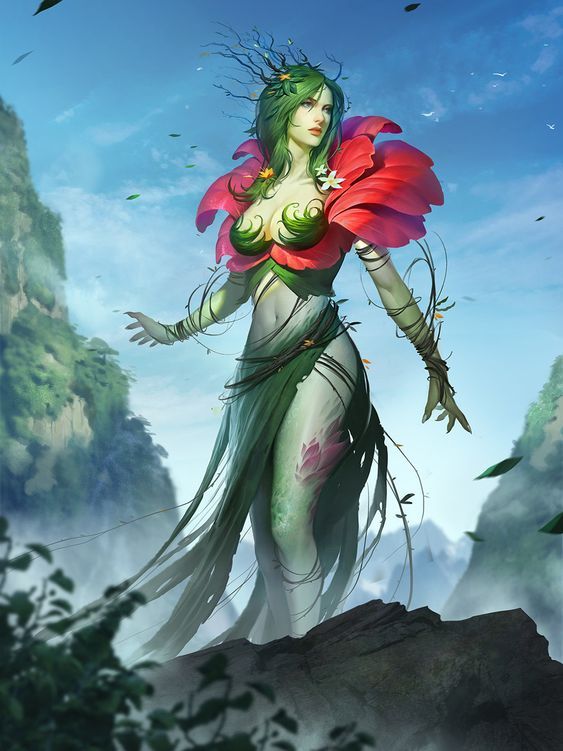Olvaredhel
Fun-loving plant-person guardians of nature
A strange combination of plant and elf, olvaredhel are the kind, nurturing champions of the natural world. They often take offense to the wanton destruction of nature when it occurs, and show little mercy for unnatural creatures walking the land. They are also naturally curious and often suffer from wanderlust.
Basic Information
Anatomy
Olvari are a unique mixture of edheli mammal and various types of foliage. Each wild elf has a different combination of floral growths unique to the individual. The floral growths are generally as sensitive as any cartilaginous part of their body. On a cellular level they are mostly mammalian, but wild elf cells have both mitochondria and chloroplasts that work in concert to power the cell. However it is the power of magic that allows olvari to exist at all, much less continue to breed with such a mixture of biology.
Genetics and Reproduction
The olvaredhel reproduce sexually, like any other edhel. The specific biological processes of fertilization might be slightly different, but the general method remains familiar.
Dietary Needs and Habits
Most wild elves don't need to eat if they get enough time in the sunlight. But when that is not possible, they almost never eat foliage, preferring to consume animals and insects.
Biological Cycle
In a plant-like fashion, olvari tend to wilt/shed during colder months and become more subdued, while during warmer months their foliage tends to blossom brightly with new growth and make them energetic. These effects are mitigated when the olvari is around others, indicating the mood swings are more psychological than the physiological changes would lead one to believe.
Additional Information
Social Structure
Wild elves tend to form 'circles', which function like extended family units, with geographically and chronologically close neighbors, particularly those with similarly-aged offspring.
Facial characteristics
Wild elves vary greatly in features. However most have earth-toned eyes in greens, hazels, and browns, with similar coloration for hair. Olvari are also the only elven subspecies that can grow facial hair in the males.
Civilization and Culture
Gender Ideals
In both genders' cases, the ideal male and female are both icons of fertility, meaning the same thing it means in human society: large primary and secondary sexual characteristics and thick, healthy hair/foliage.
Courtship Ideals
Olvari tend to be playful in courting rituals, finding joy in the blossoming of romance and thus trying to delay the consummation of such as long as possible, at least a full seasonal cycle (a year).
Common Dress Code
Most wild elves grow foliage that functions as clothing for them. When additional clothing is needed, it is often designed in imitation of flowers and other plants. Wild elf foliage isn't removed (which would be akin to removing a human's ear or finger), but can be moved aside when necessary.
History
Wild elves are a relatively new subspecies. Unlike other edheli, their origins are not prehistoric. Instead, it was the tail end of the Ice Age that they were created by The Effects of Magic. When the goddess San'Gaia ascended to become the deity of the natural world her act of ascension was to cause the plantlife in the forest she called home to give rise to the olvaredhel as champions of nature. These first olvari traveled the globe and founded Groves deep in the wild swamps and forests of Torar, from which more olvaredhel were spawned. This generation were born curious about the world and began to explore, introducing themselves to the rest of the world finally. They were also able to reproduce sexually with each other instead of being grown like fruit from the Grove trees. The olveri born before The Culling were known as wyldlings in the Common tongue, and were much more plant-like than today's wild elves are.
The Culling destroyed all of the Groves, and badly weakened olvari connection to the world and their goddess. As a result, new generations are more elf than plant. While most still choose to build their lives deep in ancient forests and other wildlands, more and more have begun to integrate into other societies.
Interspecies Relations and Assumptions
Most olvari aren't particularly interested in relations with partners that aren't olvari. There is a slight social stigma against such pairings, though any such offspring are either full olvari or full whatever the other species in the relationship is.
Genetic Ancestor(s)
Scientific Name
Homo sophos concordia
Origin/Ancestry
Mammalian, Plantae
Body Tint, Colouring and Marking
Skin tones range from green to olive to varying shades of tan and brown. Wild elves can have body markings and patterns, generally in the form of spots, along frequently folded areas of skin such as the neck, armpits, groin, and limb joints. In general these markings are a darker shade of the olvari's skin color.



Comments